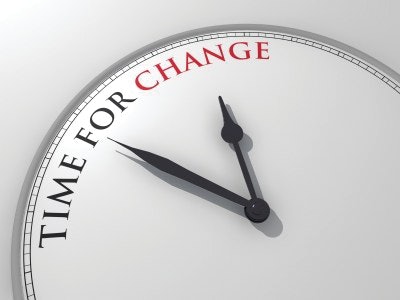
Do you feel blessed to have so many dedicated, effective people working for you? Or do they leave you wanting for better?
Is your business performing like you expect it to, or is it struggling to find good work?
If you answered yes to either of those two questions it's time for a change in the way your business is running.
In this article, we will be focusing on how to drive positive change through your business. The commonly used term for this activity is Change Management.
You see, businesses aren't like cars. You can't just taps the brakes and turn the wheel to change direction.
Changing direction with your business involves changing priorities, changing work assignments, changing bonus plans. It means changing the habits of every employee that works for you. It also means changing the sales, estimating, production management, costing, and staffing processes.
First and foremost, changing your business means changing the way you think; the way you treat people; the way you treat prospects; the way you treat customers; and ultimately, the way you treat your employees.
Changing your business means you will be making some tough calls on old friends. It means following through on decisions you've put off for a long time as they were distasteful and unwelcomed.
It means everyone's daily grind will feel uncomfortable for a while before the new and better way becomes familiar. Habits are like that.
Change requires having the fortitude to stay the course when doubt creeps into your mind and progress looks hopelessly lost.
What all of the above means is that change must be MANAGED.
Positive change doesn't come about by accident. Positive change doesn't just occur. It must be planned. It must be carried out with ruthless consistency. Positive change is purposeful.
How to change employee behavior
After spending several years working with large businesses as a management consultant, one truth became crystal clear. In the end, all it takes to significantly alter employee behavior is to adjust the performance review and the pay systems.
To start implementing positive change in your business, look at how you review work performance and how you pay your workers. Are they two systems promoting the behaviors that you want? Are they promoting the behaviors that support your strategy? Are you rewarding the right people - the people who work hard, make good decisions and are committed to your company's success?
How often are you giving feedback - positive and negative? Ever?
How often are you double checking individual priorities? Monthly?
How recently have you reviewed the job descriptions and gone over them one-on-one with each member of your organization? Ever?
All three of the above are MUSTS. Failure to do so will result in uneven, or even poor, performance. They also are three of your most important levers for driving change.
Performance management tools are the here-and-now tools for driving behavior. The compensation system is the longer-term tool for driving behavior. Your best employees deserve to make more than your less-than-best. The safest way to pull that off is via a bonus system. A bonus system leaves some pay at risk and better connects performance to W-2. Their wage should be market compatible for their talents, skills and adaptability.
Sales professionals should be rewarded for improving your bottom line. That reward should be directly tied to margin. Do not tie it to volume (i.e. project price). Anyone can land work at the lowest price. That is not a behavior to reward, whether the person is an estimator or a sales professional. To bonus an estimator, focus on his budget accuracy -
specifically how well he predicts man-hours. Bonus (actually pay) salesmen on the gross profit they create.
How to manage strategic change
Strategic change means changing the clients and markets you pursue and changing the way you compete. Strategic change requires research, planning and adaptability.
In the case of strategic change, you are looking to change your business model. If you do not need to change your business model, if you just need to work your business model better, then you don't need strategic change.
As business coaches, we almost always challenge our new clients' business models. That doesn't mean we always believe they need to be changed. We have just learned that more often than not, contractors adhere to broken business models.
Make sure you give thorough and legitimate consideration to your existing business model prior to deciding the exact way you want your business to run.
How to drive change
There are three common approaches for driving change within a business.
Approach #1: the owner drives the change.
Approach #2: the owner retains an outside change agent (i.e. coach or consultant).
Approach #3: the owner hires someone and empowers her or him to change the company.
Approach number one is the most commonly used technique - and typically the least successful. The challenge boils down to: the person who put the business in its current position typically is not well equipped by skill or reputation to successfully drive significant positive change.
Shoving aside the skill piece, as skills can be developed, the core problem is managerial and leadership reputation. If you've spent years reinforcing your company's current culture, few employees will believe your commitment when you strive to overhaul it. Basically, you will have a company full of Doubting Thomases. About the only way to overcome that efficiently is to turn over a large part of the staff. As that is probably something you're going to have to do anyway, don't reject that solution out of hand.
Approach number two is the most reliable approach. Outside change agents take the heat off of you. They provide great cover for the unpleasant staffing and performance management decisions that will need to be made. Reputable outsiders know exactly what needs to be done and how to get it done. Your role is to communicate your full endorsement of the new direction and to work with the coach to ensure his efforts are perfectly aligned to your goals and objectives.
Approach number three is the most effective approach if you can find the right person to hire. An internal employee carries greater credibility regarding your commitment to the new direction. Bringing in a high paid team member signals that you are putting your money where your mouth is. It shows that you're shoving all of your chips into the pot.
Get it right the first time
Each unsuccessful attempt to drive change will make the next one more difficult. People will either distrust your commitment or distrust your abilities. The grapevine will be saying "Here we go again." The staff will naturally assume that if they resist the change long enough it will fade away into the sunset, and they will soon be able to return to business as usual.
If you are dissatisfied with the way your business is running, you need to implement change. When you do, you need to manage the change aggressively and without deviation from the chosen path.




















